For more than two thousand years, humanity has been trying to solve all the mysteries of this severe dermatosis, but much is still unknown. According to statistics, this disease affects 4 to 7% of the population, women and men are equally susceptible to it. The first signs of psoriasis usually appear at puberty and accompany a person for the rest of his life, then they subside and disappear completely, and then they intensify.
Can psoriasis be cured?Modern medicine has achieved a lot in the treatment of this chronic dermatosis and is able to provide the patient with a decent level of quality of life.
Causes of psoriasis
Psoriasis is a chronic skin inflammatory process, which modern medicine calls autoimmune (associated with an allergy to one's own tissues). There are many causes of psoriasis and factors that predispose to the development of this dermatosis, in connection with which several theories about its origin have been presented.
Autoimmune
This is a major theory because it has been well established that the immune system actively responds to certain types of skin exposure. The skin of people suffering from psoriasis is very sensitive to mechanical, physical and chemical influences. Not only epithelial cells but also the entire immune system responds to such influences.
Cellular immunity is impaired: the ratio between individual subtypes of lymphocytes responsible for creating a normal immune response. Thus, in psoriasis, the number of helper T-lymphocytes - helpers that regulate immunity - increases, while the number of suppressor T-lymphocytes, suppressing an excessively strong immune response, decreases. Lymphocytes and some other cells produce cytokines - active substances that stimulate the immune response. Humoral immunity also suffers, an imbalance of antibodies (immunoglobulins) develops in the blood serum, antibodies appear on the tissues of the patient's body.
Inflammation begins in the background of T-lymphocyte activation, but why they are activated has not been determined. The research process also raises the question of how to suppress the autoimmune response without harming the patient.
Exchange
An imbalance in metabolism significantly affects the skin and immunity. In patients with psoriasis, there is an acceleration of metabolism, the appearance of large amounts of toxic free radicals and other toxins that support the inflammatory response. Metabolism is disturbed:
- protein- CDSN predisposition gene stimulates the synthesis of the protein corneodesmosin, which sensitizes (allergens) the organism; the protein albumin content in the blood decreases and the globulin content increases; this condition is called dysproteinemia and further intensifies sensitization;
- greasy- the content of lipids and cholesterol in the blood increases; the use of predominantly plant foods and a general reduction in calories in the daily diet can reduce the activity of psoriatic inflammation;
- carbohydrates- almost always violated;
- exchange of vitamins and minerals- the content of vitamin C in the skin increases, the content of vitamins C, A, B6, B12, iron, copper and zinc in the blood decreases.
Infectious
This theory was relevant at the beginning and middle of the last century. Certain bacteria (streptococci), fungi and viruses have been considered to cause psoriasis. These theories have not been confirmed. But dermatologists note that any acute infectious process or the presence of a permanent focus of infection can cause relapses. Virus theory occupies a special place. Recent research has revealed the effect of retroviruses (viruses that contain RNA - HIV, etc. ) on the genetic apparatus by forming genes for psoriatic predisposition.
Genetically
Predisposition to autoimmune reactions is inherited. If loved ones suffer from psoriasis, then the probability of developing this disease increases many times over. There are genes for susceptibility to psoriasis (local complexes PSORS1 - PSORS9, PSORS1 is particularly active, it contains the genes HLA-C, HLA-Cw6, CCHCR1 and CDSN which are responsible for the development of the disease). Genes affect metabolism, immunity and the development of autoimmune processes. But the presence of such genes does not guarantee the development of the disease. The influence of provoking factors is of great importance.
Neurogenic
Prolonged stress, high neuropsychiatric stress, disorders of the autonomic nervous system (innervation of the walls of blood vessels and internal organs) can cause the development of psoriasis, causing an imbalance in the endocrine system, disturbed metabolic and immune processes.
Endocrine
Endocrine disorders in psoriasis are common and mainly play the role of a provocative factor. A clear connection between the two has not been proven. Dermatologists note that patients often have thyroid, adrenal, and pituitary dysfunctions. There are menstrual irregularities in women and sexual function in men.
Symptoms of psoriasis
The main symptoms of psoriasis are skin rashes. But there are other signs. The first manifestations usually appear in adolescence or childhood in the background of hormonal disorders, vegetative-vascular dystonia and long-term stress.
The disease begins with a feeling of constant fatigue, mood disorders. They are characterized by small, pink formations (papules) that rise above the surface and are powdered with whitish peeling from above. They are surrounded by a brighter, high rim.
The elements of the rash grow and combine into large plaques of bizarre shapes. The base of the papule is an inflammatory infiltrate. By the nature of the rash, psoriasis is divided into:
- point- elements with a diameter of not more than 1 mm;
- tear- papules-drops up to 2 mm;
- in the form of coins- round papules-coins up to 5 mm in size.
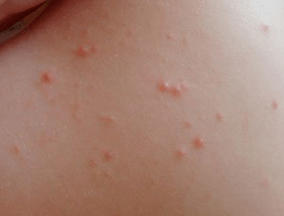
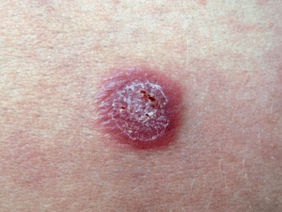
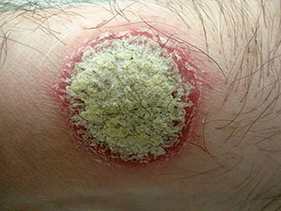
Characteristic characteristics of the rash:
- stearin stain- if you scrape, the surface of the papule;
- terminal film- By thoroughly cleaning the surface of the papules from scales we will see a transparent film;
- bloody dew (Auspitz phenomenon)- scraping the film and violating its integrity, we will see small blood droplets protruding from the surface.
Stages of psoriasis
There are three stages of the disease:
- progressively- the first elements of the rash appear, their number increases, all new areas are affected; the rash also occurs when scratching the itchy skin or exposure to some external irritants (Kebner phenomenon); in the initial stage of psoriasis, the papules begin to merge into large plaques;
- stationary- there are no new elements, and those that appeared earlier do not regress;
- regressively- the rash turns pale, its base becomes less dense; the rash gradually recedes, the process often starting from the central part, so that the plaques may have the shape of rings; if the plaques in psoriasis dissolve from the periphery to the center, then they simply gradually decrease and a white ring is formed around them - Voronov's pseudoatrophic rim; where there was a rash, white, pigmented areas remained - psoriatic leukoderma.
Occasionally, papules are present on the skin at the same time in all three stages of development. There are both summer and winter forms with a predominance of deterioration during summer or winter.
Is psoriasis contagious?
Numerous studies have confirmed that this is not a contagious disease. If infectious pathogens participate in its development, then only through a general effect on metabolism, immunity and the genetic apparatus.
Patients often ask:
- How does psoriasis spread?
Psoriasis is not transmitted from person to person.
- Is psoriasis inherited?
The answer is again negative, but there is a hereditary predisposition in the form of metabolic characteristics and functioning of the immune system, which is transmitted to close relatives.
Types of psoriasis
The nature of the rash, their location, damage to other organs and systems in this chronic dermatosis can be different. According to these signs, several types of diseases are distinguished.
Simple (vulgar, plaque)
The most common. Its symptoms are papules of a characteristic bright pink color, covered with white scales. Downstream plaque psoriasis is divided into the following forms:
- easy- if the lesion covers a maximum of 3% of the skin; in the progressive phase, the papules enlarge, but then rapidly undergo reverse development;
- moderate- rash lasts from 3 to 10%; the papules are large, merging into plaques;
- heavy- defeat of the project more than 10%; the rashes are numerous, merging, forming a wide range of shapes.
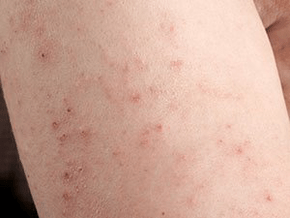
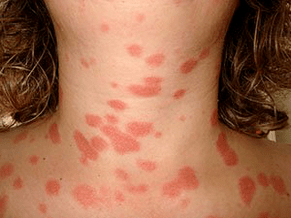
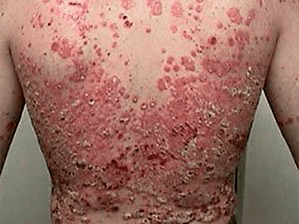
Vulgar psoriasis passes in the form of recurrence, alternating with remissions, but there is also a continuous course.
Elbow psoriasis
This is one of the manifestations of a mild form of plaque inflammation. A characteristic feature of psoriasis on the elbows is the constant presence of one or more "duty" plaques on the extensor side of the elbow joints. If these elements are injured, deterioration begins.
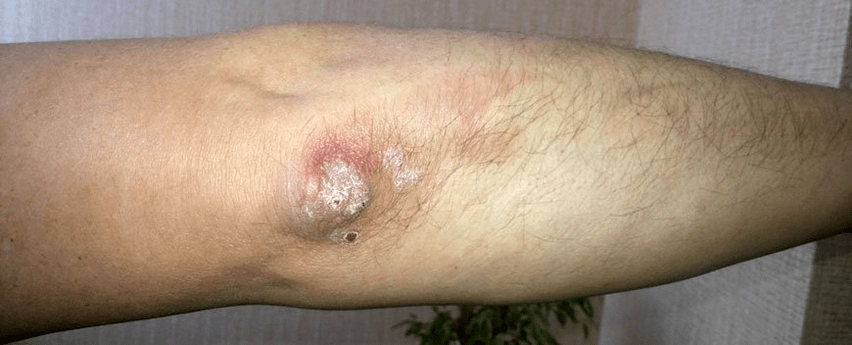
Guttate psoriasis
Bacterial (usually streptococcal) and viral infections are of great importance in the development of guttate psoriasis. It occurs in childhood. Inflammation begins after infection. Streptococci secrete toxins (antigens - substances foreign to the human body) that bind to tissue proteins. They produce antibodies and develop autoimmune inflammation.
The onset is acute. On the skin of the extremities (rarely the body and face) small red papules-tears with a scaly surface appear. With injuries in the area of the rash, small erosions and ulcers form, the risk of infection increases.
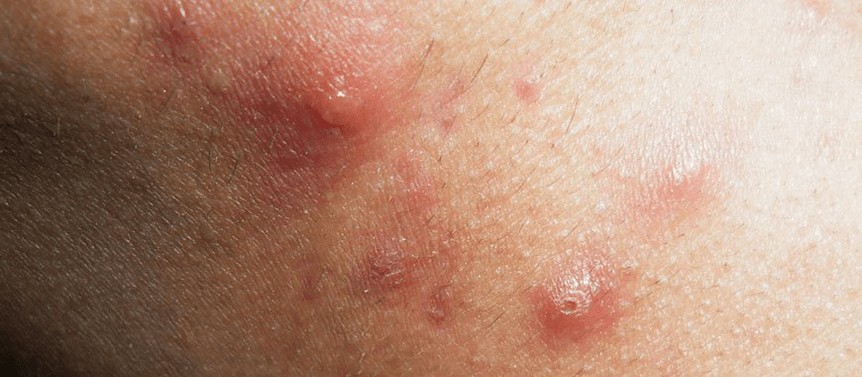
Psoriasis quickly takes a subacute and chronic course. Relapses are replaced by remissions, independent recovery or transition to an adult form of the disease is possible.
Palmar-plantar psoriasis
It develops in those who engage in physical work, is accompanied by severe itching and almost always creates complications on the nails. There are subtypes:
- in the form of a plaque-shaped fan- with large elements on palmar and plantar surfaces, covered with white scales, merging into fan-shaped tiles; such psoriasis on the hands is more common;
- circular- annular scaly elements on palmar and plantar surfaces;
- horny- characterized by the growth of rough epithelium with the formation of corns;
A separate subtype is pustular psoriasis on Barber's palms and feet. The areas under the thumbs of the extremities are covered with vesicles and pustules (with purulent contents), severe itching occurs. The abscesses melt and then dry out, forming crusts. Elsewhere on the body, characteristic psoriatic elements develop. The disease often spreads to the nails.
Psoriasis on the legs is maintained and exacerbated by varicose veins, in which case the rash will mostly be in the lower leg area.
Nail psoriasis
Nail damage can be independent or a complication. Typical symptoms:
- small plates of varying depths appear on the nail plate; similar nail lesions are found in other dermatitis, but in psoriatic lesions they are deeper and slightly painful when pressed;
- spontaneous slowly painless separation of the nail (onycholysis);
- subungual bleeding on the nails, especially if the patient wears tight shoes;
- trachyonychia - turbidity and irregularities on the nail plate; a depression forms in the middle of the nail and the nail becomes like a spoon (koilonychia).
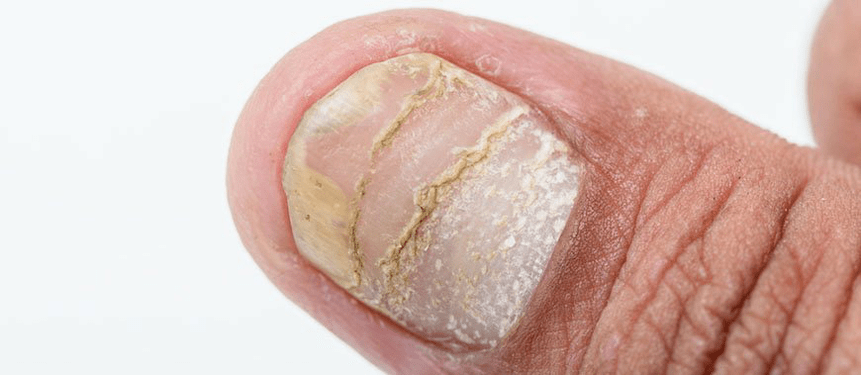
Sometimes the periungual roller is affected by the transition of inflammation to other tissues (psoriatic paronychia).
Scalp psoriasis
Here the disease passes on its own or as part of a general pathological process. It is characterized by leakage, the formation of crusts on parts or on the entire surface of the head. Hair growth is not affected at the same time: psoriasis on the head does not impair the function of the hair roots. But a leak creates a risk of infection with subsequent damage to the hair follicles.

It flows in waves, then calms down with the disappearance of the crust, then worsens again and is accompanied by severe itching, which often leads patients to neurosis.
Seborrheic psoriasis
Seborrhea is a condition caused by a malfunction of the skin glands that produce sebum. It produces a viscous oil that irritates the skin and contributes to the development of inflammation - dermatitis.
Seborrheic psoriasis spreads rapidly to the entire head, covering it in the form of a cap and accompanied by severe itching. In the areas behind the ear, crying sometimes develops and an infection joins. The head covered with dandruff and a hard cover sometimes looks like a psoriatic crown.
Psoriasis on the face
Usually, psoriasis on the face is localized in the area of the nasolabial triangle, eyelids, above the eyebrows, in the areas behind the ear. The combined elements of the rash form large areas of redness and swelling. If there is sebaceous gland dysfunction, the process is often accompanied by crying, crusting and an increased risk of infection.
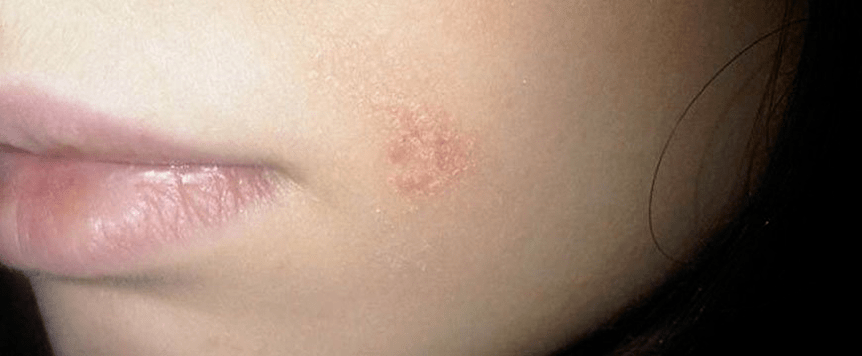
Psoriasis of the genitals
This is not an isolated process. Simultaneously with the defeat of the genitals, characteristic psoriatic rashes appear all over the body, so it is not difficult to recognize the disease.
Psoriasis on the penis in men and on the labia majora in women, as well as on adjacent parts of the skin, manifests itself in the form of oval, pink scaly papules that rise slightly above the skin. There is practically no itching. Sometimes the process spreads to the mucosa and looks like vulvovaginitis in women and balanoposthitis in men.
Atypical psoriatic rashes can be observed in obese people in folds located next to the genitals (inguinal, intergluteal). This creates areas of intense red color with a mirror-like surface with no signs of peeling due to constant wetting.
What is the danger of psoriasis and should it be treated
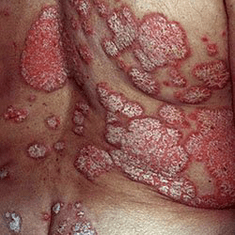
The danger is that psoriasis can take a widespread severe form, the rash will occupy more than 10% of the skin. This stage of the disease is severe, relapses, elements of the rash are injured and get wet, infection often joins. Only timely treatment of psoriasis can stop the process of its spread.
Sometimes the disease is complicated by inflammation in the joints with the development of psoriatic arthritis, against which the function of the joints can be significantly impaired.
In the background of the systemic autoimmune process, which significantly affects the patient's condition, other autoimmune diseases often develop (rheumatoid arthritis, some types of arthrosis, Crohn's disease, etc. ), as well as severe cardiovascular pathology, diseases of the digestive system, neurological reactions.
If you do not start psoriasis treatment on time, the patient's condition will deteriorate dramatically and lead to disability.
There is also such a complication as psoriatic erythroderma, which develops with improper or insufficient treatment of psoriasis, as well as when various irritating factors are exposed to inflamed skin. The skin acquires a bright pink color with a clear demarcation of the affected areas from healthy, small and large lamellar peels. Such a patient requires urgent medical attention.
Is psoriasis treatable?
Yes, and very successfully, but a full recovery cannot be guaranteed.
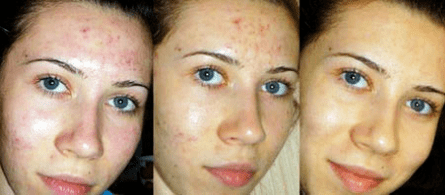
Methods of treatment
Autoimmune inflammation requires individually selected complex therapy, lifestyle changes, diet, and elimination of all bad habits. Modern medicine has proposed three basic principles for the successful treatment of psoriasis:
- strict adherence to the algorithms for prescribed therapy;
- regular monitoring of the effectiveness of therapy;
- timely correction of prescribed therapy with its insufficient efficiency.
Diet for psoriasis
There is no specific diet for psoriasis, but nutrition is of great importance. Therefore, when prescribing a complex treatment, dietary recommendations are necessarily given:
- recognize the increased sensitivity of the body to certain foods and exclude them from the diet;
- give preference to fresh vegetables, unsour fruits and berries, cooked and roasted lean meat, drink more;
- what not to eat with psoriasis:
- products containing essential oils - onion, garlic, radish;
- beverages containing caffeine (concentrated tea, coffee), alcohol;
- everything is saltier, sour and sweet, rich;
- products that promote sensitization (allergy) of the body - orange fruit, honey, nuts, cocoa, eggs;
- do not eat fatty animal products.

Pegano diet for psoriasis
This diet was developed by American physician John Pegano, but has not found official medical recognition. The principle of building a Pegano diet for psoriasis is associated with alkalizing the body by choosing the right diet. According to this principle, all products are divided into:
- alkaline formation (two-thirds in the daily diet) - non-acidic mixtures of fruits and berries and juices, vegetables (excluding those that cause increased gas production);
- acid forming (one third of the diet) - meat, fish, dairy products, beans, peas, potatoes, cereals, sweets and pastries.
Patients are recommended to drink mineral water without gas, drinking water up to 1. 5 liters per day, as well as other liquids (compotes, juices, etc. )
Drug therapy
Mild psoriasis is treated with topical medications. Severe and rapidly progressing forms of the disease are treated mainly in the hospital with the prescription of drugs of general (systemic) action.
External treatment of psoriasis
The medicine is chosen by a dermatologist. For vulgar psoriasis with dry constriction plaques, ointments are suitable, if a leak develops (with seborrheic), then creams and medicinal solutions are used. To avoid the body's resistance (resistance) to a particular drug, it changes over time.
In the acute (progressive) stage, the following external therapy is performed:
- agents that have a emollient effect - boron vaseline, 2% salicylic ointment;
- effective non-hormonal ointments for psoriasis containing activated zinc pyrithione; suppress infection and have a cytostatic (suppress tissue proliferation) effect;
- external agents containing glucocorticosteroid (GCS) hormones;
- combined agent with calcipotriol (vitamin D3 analogue) and corticosteroids betamethasone; perfectly suppresses the inflammatory process.
External treatment of inpatient psoriasis:
- shell-dissolving fats (keratolytic) and anti-inflammatory - 5% naphthalene, boron-naphthalene, tar-naphthalene;
- corticosteroid drugs.
External treatment of psoriasis in the resolution phase:
- the same keratolytic fats, but in a higher concentration: 10% tar-naphthalene fats;
- fats based on vitamin D3 analogues - within 6 - 8 weeks; suppresses the inflammatory process and peeling rash.
For the treatment of nail psoriasis, special varnishes are used that suppress the development of the pathological process. Treatment of periungual phalanges with moisturizing gels is recommended.
Systemic treatment of psoriasis
- drugs that relieve inflammation and intoxication - calcium chloride, sodium thiosulfate, unitiol in the form of injections;
- tablets for psoriasis, which suppress the processes of proliferation (multiplication of epithelial cells) - cytostatics that suppress the activity of the immune system, vitamin A analogues, corticosteroid hormones;
- biological agents containing human monoclonal antibodies of the IgG class, acting on certain inflammatory bonds by suppressing cytokine synthesis; it is a very effective modern injectable drug;
- vitamins for psoriasis help restore metabolism and keratinization of epithelial cells; doctors prescribe vitamins A, E, D3, group B.
Folk remedies for psoriasis
Any treatment for psoriasis, including the use of folk remedies, can be prescribed only by a doctor. Self-medication can lead to the opposite effect: the spread of disease.
The following methods can be used as part of complex therapy:
- mast- industrial oil processing product; to prepare the ointment, you need to buy medical solid oil at the pharmacy; recipe: in 0, 5 kg of solid oil add 50 g of honey and half a pack of baby cream; procedures are performed daily; you can buy ready-made solidol-based preparations at the pharmacy.
- soda- folk remedy for psoriasis, which helps clean the skin, relieves itching; recipe for applying soda: take 60 g of soda, dissolve in 0, 5 liters of water, soak a gauze cloth in the solution, fold in several layers and apply on the lesion for 20 minutes; after the procedure, wipe the skin and apply any emollient ointment on it; treatment of psoriasis soda is carried out once a day;
- mummy- has a pronounced anti-inflammatory effect, well relieves itching; can be taken orally once a day, 0. 2 g for two weeks; external therapy is carried out with a solution of mummy; applied to dry itchy plaques twice daily; treatment of psoriasis on the head is carried out by rinsing the scalp with a solution of mummy after washing;
- sea salt- well relieves inflammation, itching; sea salt baths: take 1 kg of salt, dilute in two liters of water and add to the bath; bathe for 15 minutes, then rinse the solution under a warm shower, wipe the body with a towel and apply emollient ointment; treat psoriasis baths no more than twice a week;
- clay- has a pronounced cleansing effect, adsorbing on its surface toxins formed as a result of inflammation and improper metabolism; helps in drying, removing crusts and itching; you can take any clay, but it is better to buy blue clay at the pharmacy; pieces of clay must be well dried, broken with a hammer, diluted with water and left to stand for several hours; place the resulting tile-like clay on a napkin (up to 3 cm thick) and apply to the foci of inflammation for three hours; for the treatment of psoriasis with clay every other day.
Important: treatment of psoriasis at home folk remedies should be carried out with caution and strictly according to a doctor's prescription. Such treatment will help one patient, while in another it can cause worsening and rapid spread of inflammation. Therefore, if, in the background of therapy, the patient's condition worsens, it is necessary to stop him immediately and consult a doctor.
Home treatment for psoriasis
When treating psoriasis at home, it is important to adhere to dietary recommendations, lead a healthy lifestyle, eliminate bad habits and strictly adhere to all the regulations of a dermatologist.
How to cure psoriasis at home? Some patients try to cleanse themselves of toxins and toxins using all sorts of unconventional methods (enemas, etc. ). This can give just the opposite result: the work of the digestive tract will be disrupted and deterioration will begin. Modern medicine recognizes cleansing the body in the form of proper nutrition and solving bad habits.
It is important to follow all the doctor's prescriptions and pay attention to how the prescribed therapy works. If it is not effective enough, the doctor will replace the treatment achieving the maximum therapeutic effect.























